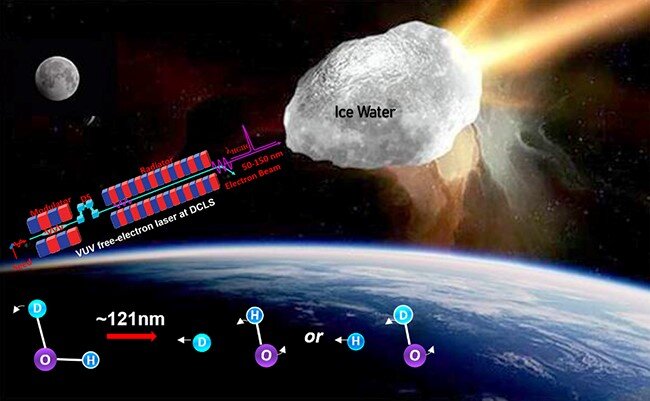Recently, a research group led by Prof. Yuan Kaijun and Prof. Yang Xueming from the Dalian Institute of Chemical Physics (DICP) of the Chinese Academy of Sciences revealed strong isotope effects in photodissociation of the water isotopologue (HOD) using the Dalian Coherent Light Source.
Their findings were published in Science Advances on July 23.
“Our experimental results illustrate dramatically different quantum state population distributions of OH and OD fragments from HOD photodissociation. The branching ratios of the H+OD and D+OH channels display large wavelength-dependent isotopic fractionation,” said Prof. Yuan.
Because water is one of the most abundant species in the solar nebula, photodissociation of water and its isotopologue by solar vacuum ultraviolet photons may be an alternative source of the D/H isotope heterogeneity, and this effect must be considered in photochemical models.
The photochemical processes identified in this work may vary the D/H isotopic ratios in the inner and outer regions, and/or in different periods of the solar nebula, which may cause the D/H isotope heterogeneity in the solar system.
Dalian coherent light source reveals oxygen production from three-body photodissociation of water
More information:
Zijie Luo et al, Strong isotope effect in the VUV photodissociation of HOD: A possible origin of D/H isotope heterogeneity in the solar nebula, Science Advances (2021). DOI: 10.1126/sciadv.abg7775
Provided by
Chinese Academy of Sciences
Citation:
Dalian Coherent Light Source reveals strong isotope effects in photodissociation of water isotopologue (2021, July 23)
retrieved 23 July 2021
from https://phys.org/news/2021-07-dalian-coherent-source-reveals-strong.html
This document is subject to copyright. Apart from any fair dealing for the purpose of private study or research, no
part may be reproduced without the written permission. The content is provided for information purposes only.
